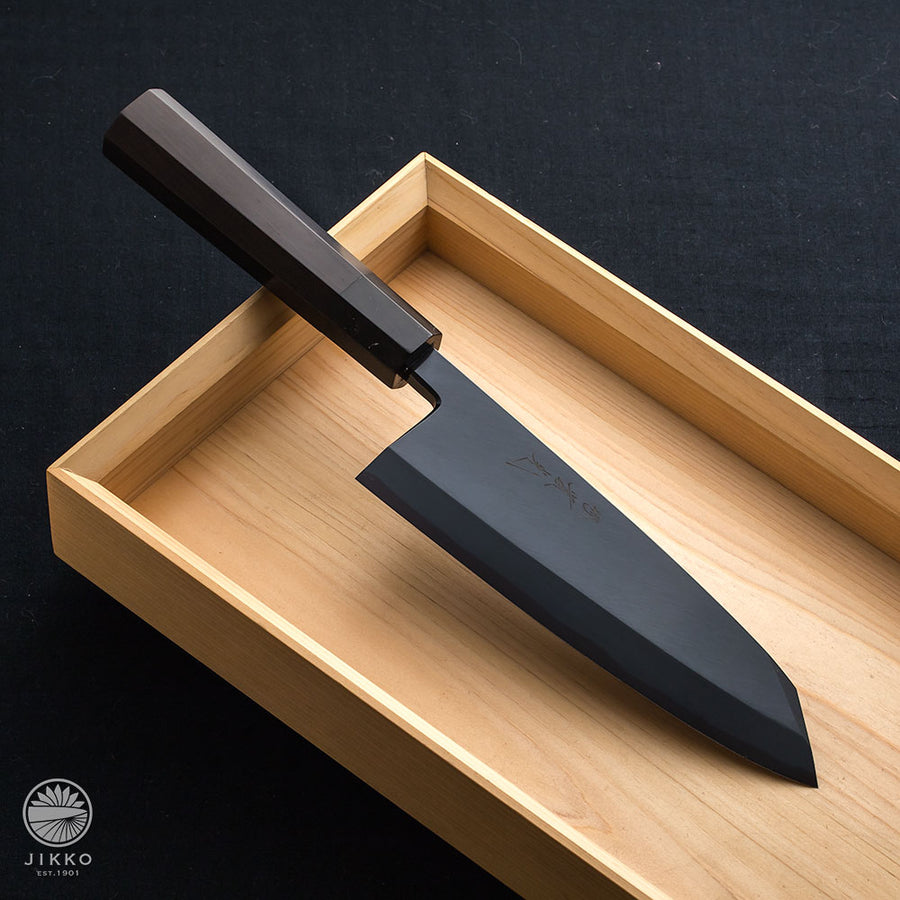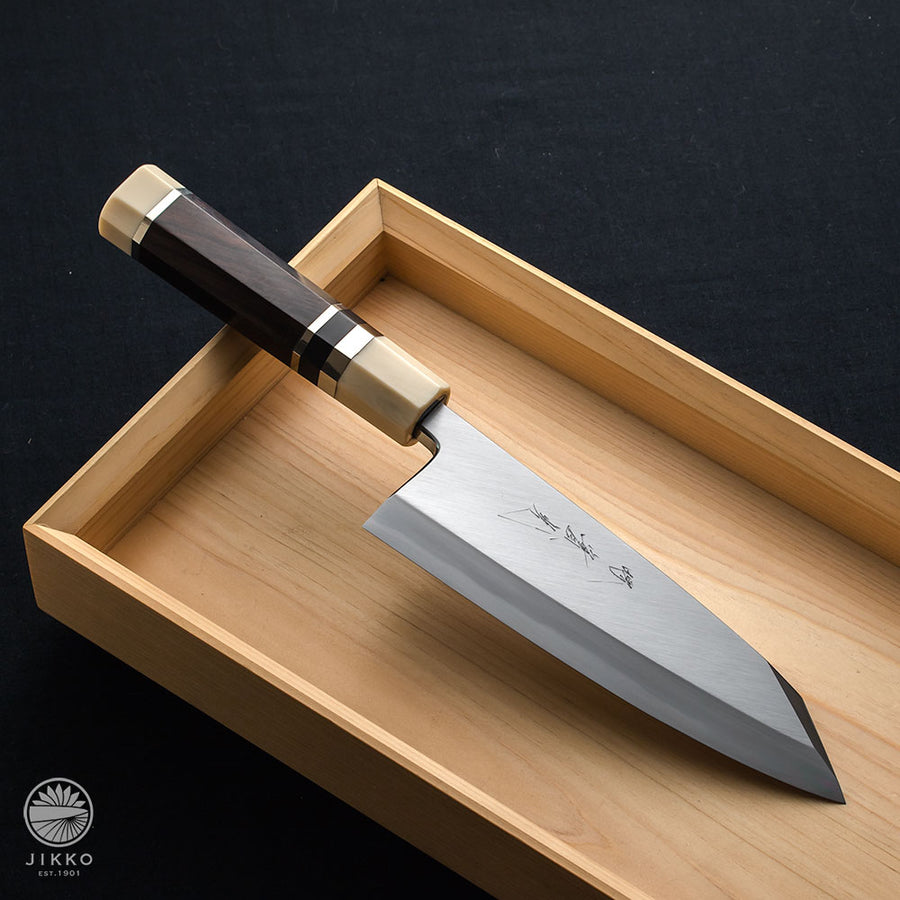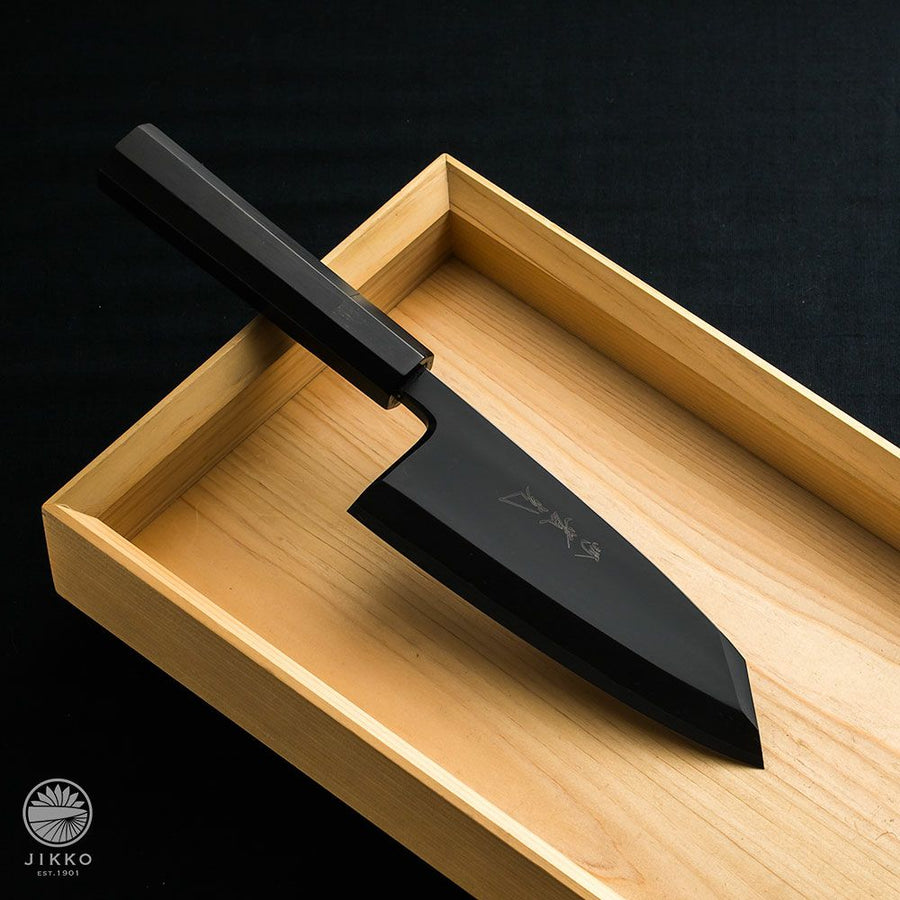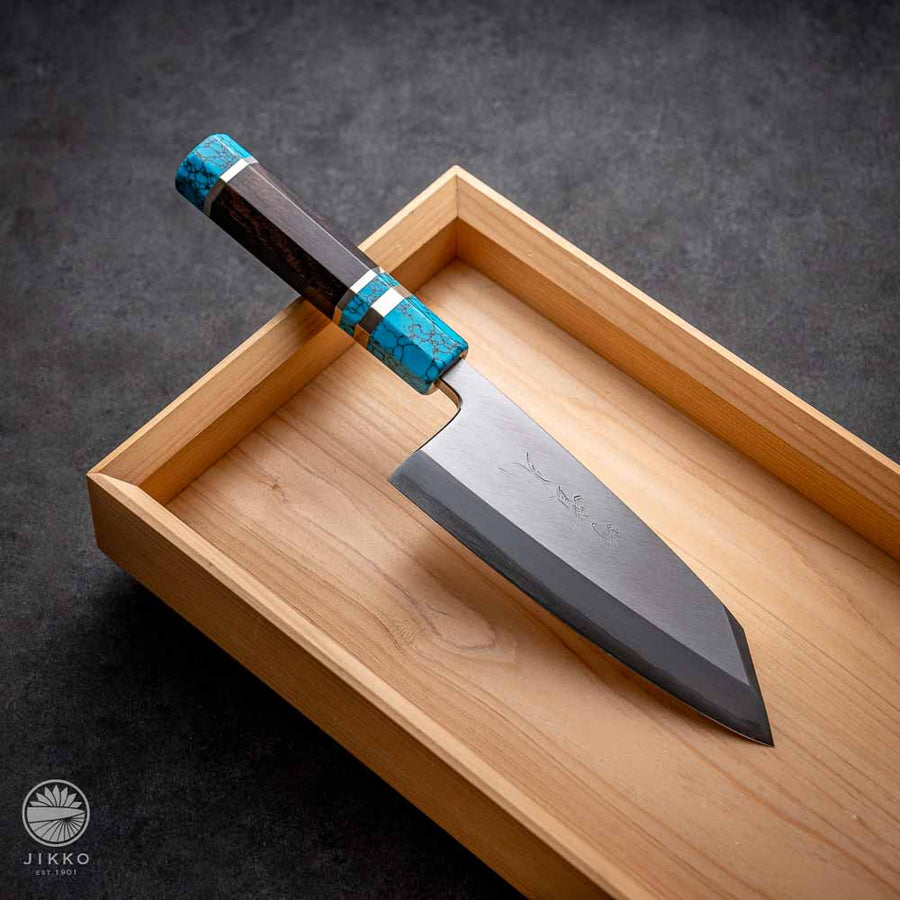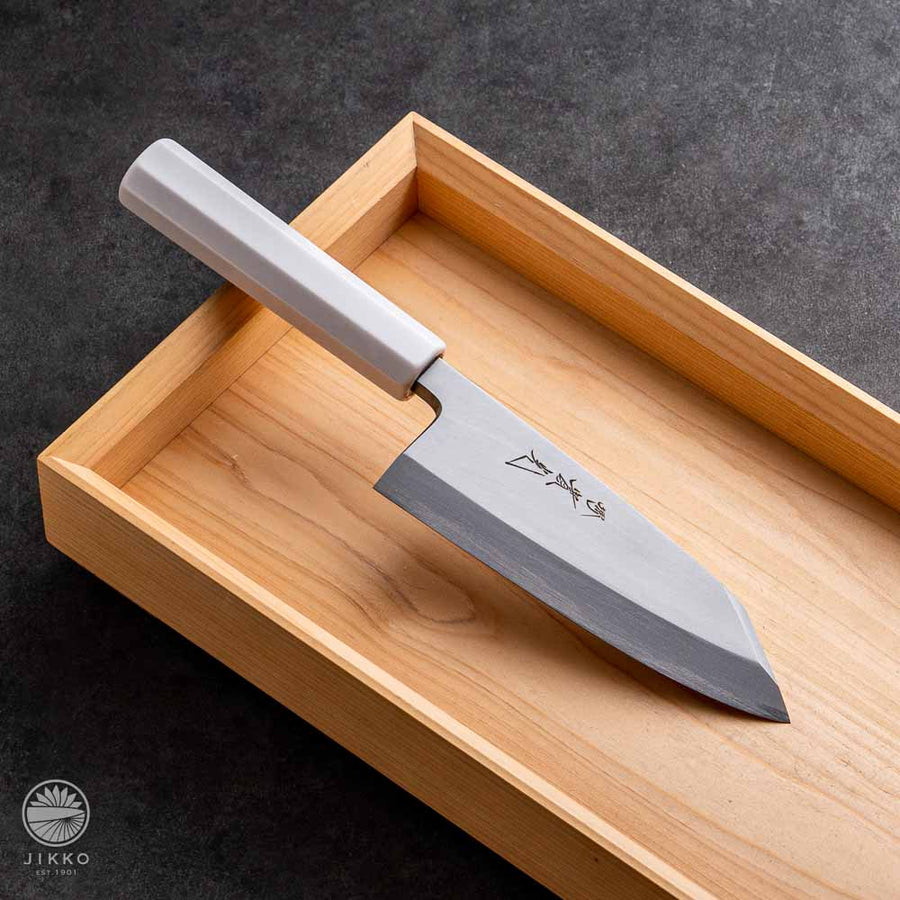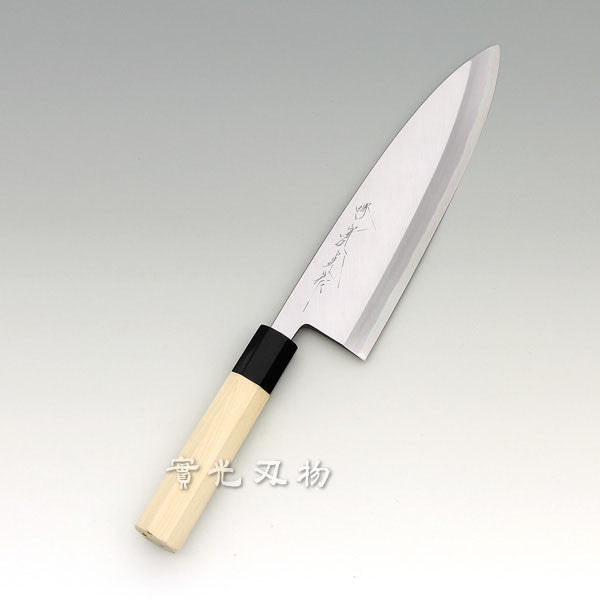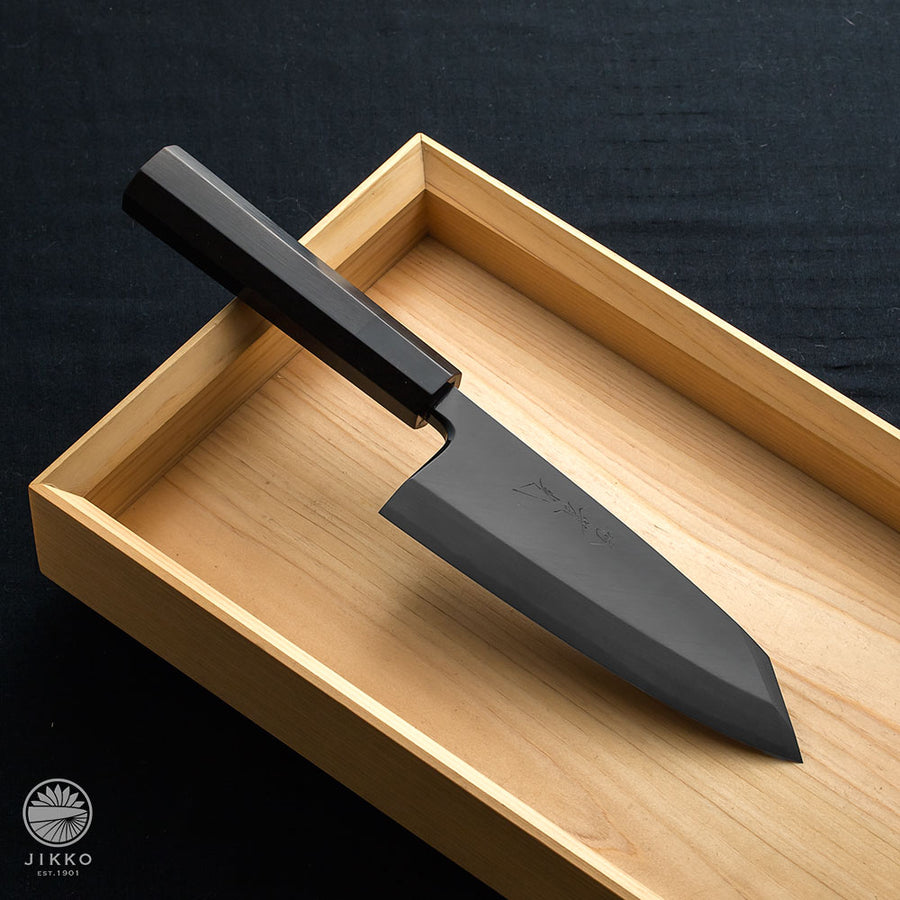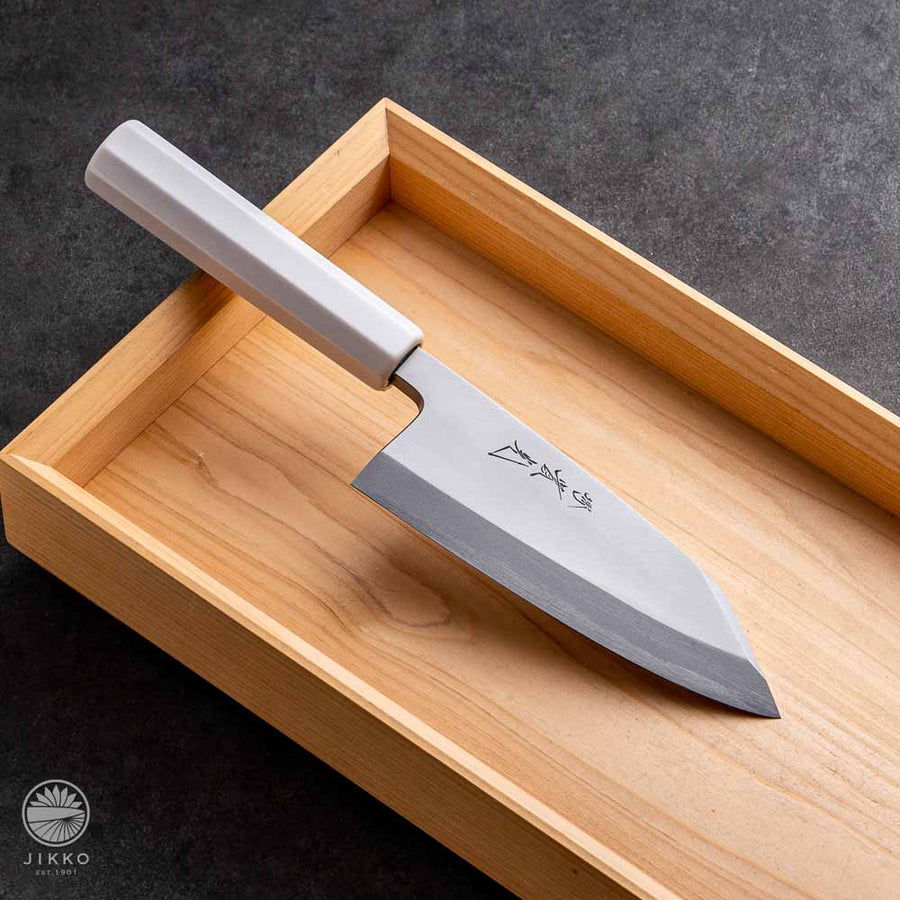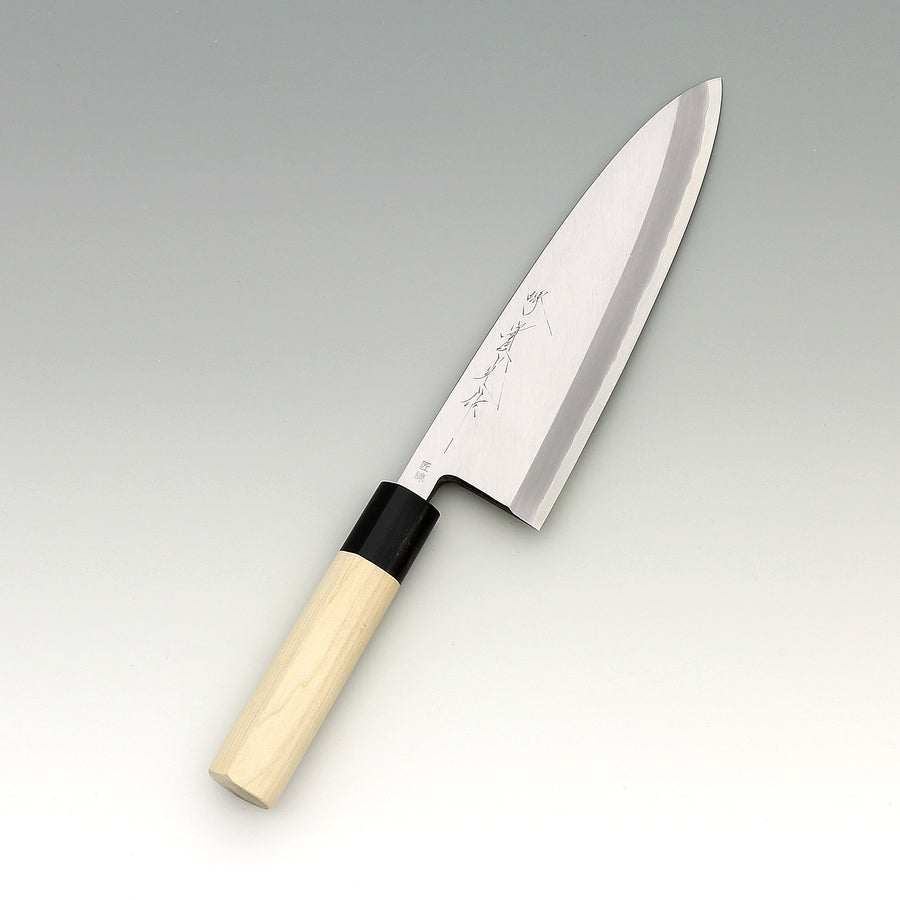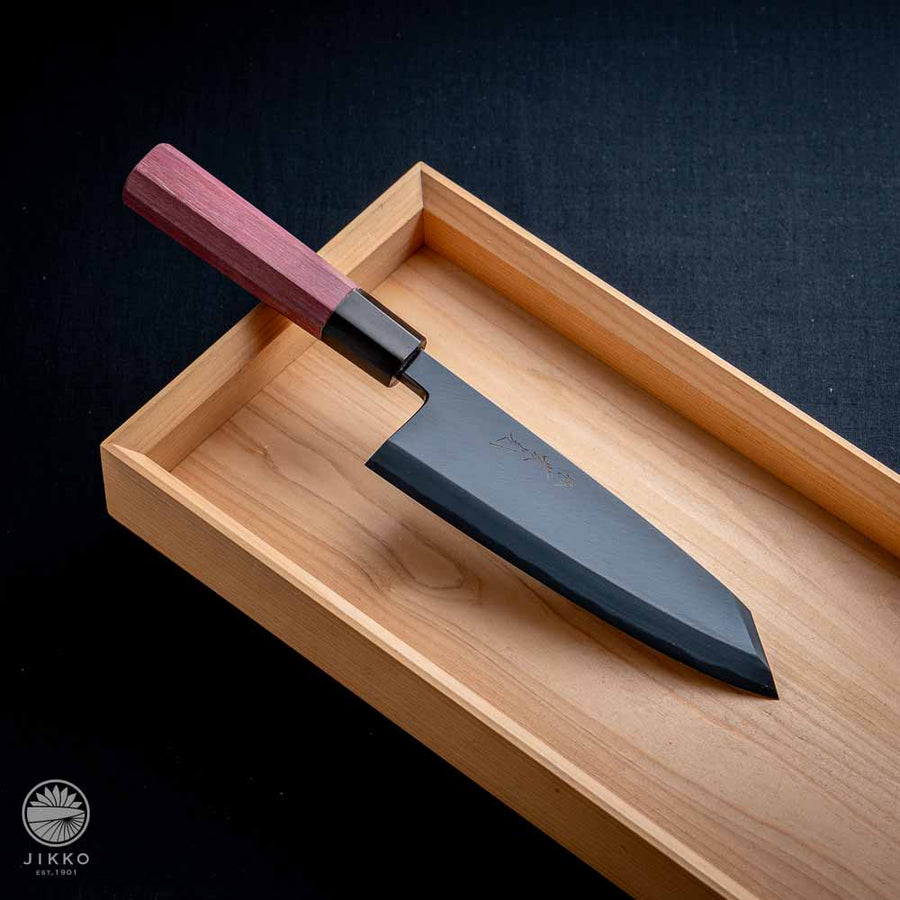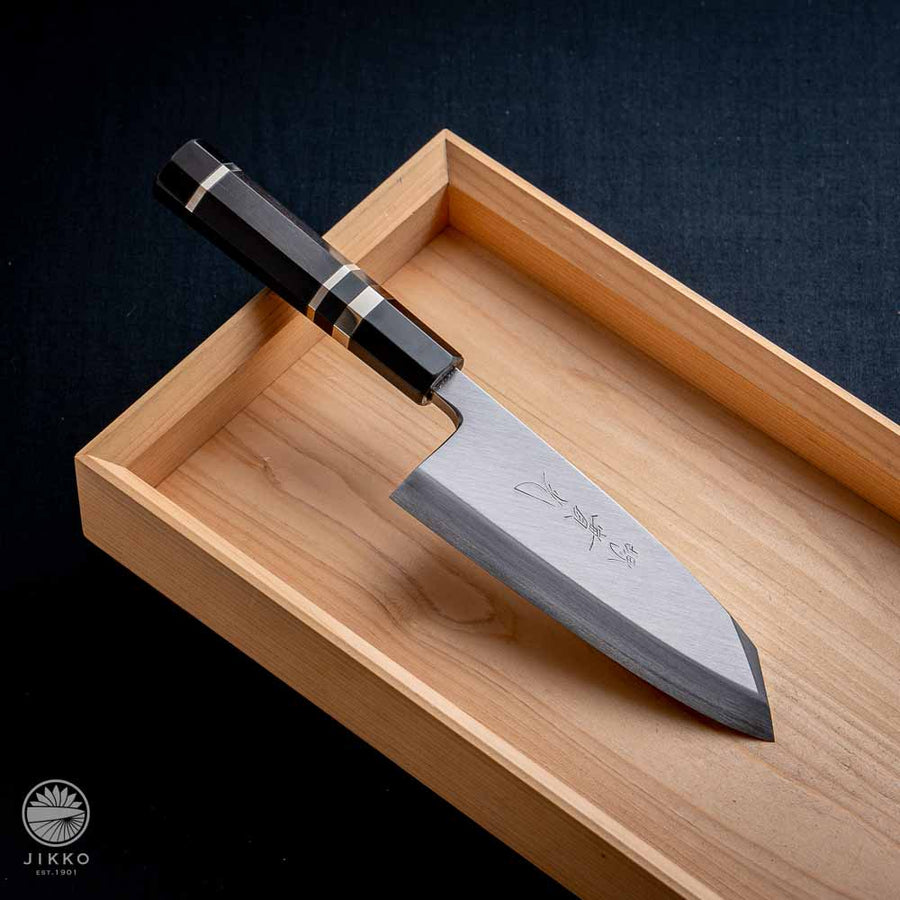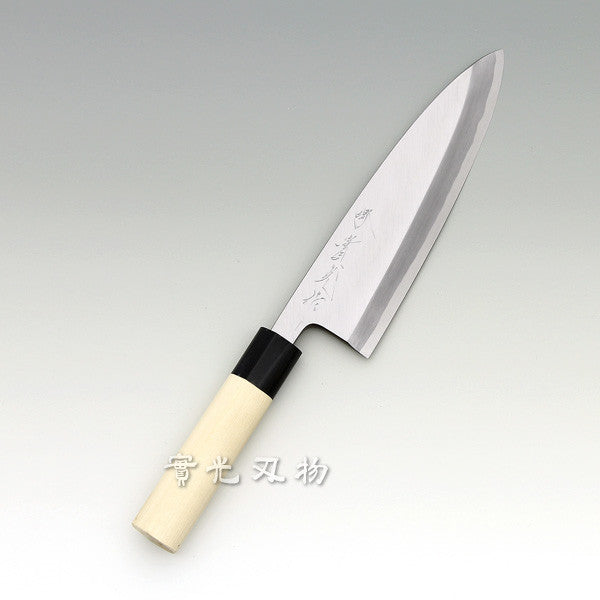
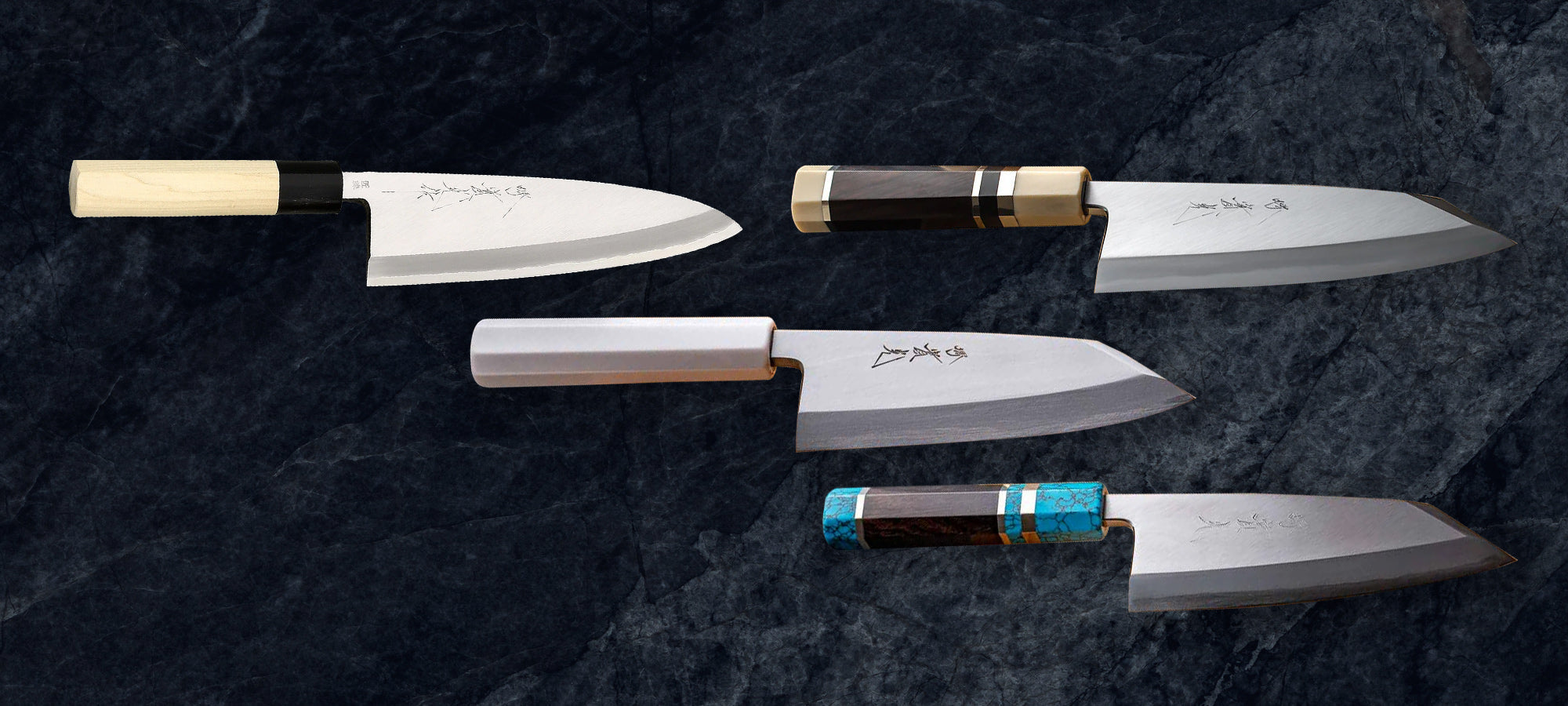
It is also recommended for cutting hard ingredients such as pumpkins other than fish.
This is a list of Deba that can be purchased online from Jikko Hamono, a Sakai JIKKO cutlery with over 120 years of history.
How to Choose a Grip
Blade Length



Select point
The size of a deba knife is typically chosen based on the size of the fish being prepared. However, for those purchasing a deba knife for the first time and unsure of the appropriate size, a blade length of around 15cm to 18cm is recommended, as it’s not too large and easy to handle.
Blade Material
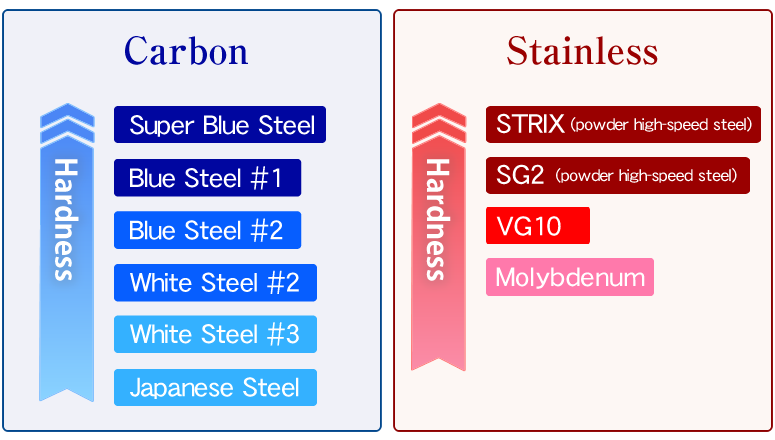
Types of Steel for Kitchen Knives
This list categorizes different types of steel used in kitchen knives. The steels at the top of each list offer the best sharpness and edge retention.
Handle type
Wa-handle

Round or octagonal shapeWood is commonly used
Select point
◾️Consider grip comfort
◾️Check balance sensation
◾️Maintenance requirements
Knife Maintenance
| Steps | Stainless Steel Knives(Rust-resistant) | Carbon Steel Knives(Prone to rust) | Icons |
| 1. Cleaning Method | Gently wash with a soft sponge and neutral detergent | Gently wash with a soft sponge and neutral detergent |  |
| 2. Remove Moisture | Wipe thoroughly with a cloth or paper towel | Wipe thoroughly with a cloth or paper towel |  |
| 3. Drying | - | Pour hot water over the blade for quick drying |  |
| 4. Light Oil Coating | - | Apply a very thin layer of vegetable oil (avoid overapplication) |
 |
| 5. Storage | Store in a dry knife stand or holder | After oiling, place in a knife stand or storage box |  |
Frequently Asked Questions
Deba is a knife that is used when cutting apart the whole fish. The knife is thick, and is durable, so it can even cut fish bones. There are different types of Deba knives, and Mioroshi knife and Ajikiri Knife are type of Deba knives. In addition, the Deba knife can also be used to cut solid ingredients like Kabocha pumpkins, and not just fish.
Deba knife can be used to fillet the fish into 3 pieces, and to cut off the head of the fish. Therefore, Deba is an essential knife to have when cooking fish dishes.
It is best to sharpen the Deba knife each time before filleting the fish. But, if it is difficult to sharpen the Deba knife every single time, you can just sharpen whenever it feels like the sharpness dropped. Since the Deba knives are used to cut off something hard like fish bones, the blade tends to be often damaged. When filleting a fish, if you are not using a knife that is sharp, the fish meat can be crushed, so it is best to sharpen to maintain the sharpness of the blade. If you feel even a slight notch when cutting, it is best to sharpen the blade of the Deba knife.
Deba is a knife that is used when cutting apart the whole fish. The knife is thick, and is durable, so it can even cut fish bones. There are different types of Deba knives, and Mioroshi knife and Ajikiri Knife are type of Deba knives. In addition, the Deba knife can also be used to cut solid ingredients like Kabocha pumpkins, and not just fish.
The Deba knives are thicker and is crafted to be durable than other knives, so that it could cut some hard like fish bones. When you cut fish from scratch, you need to cut apart the bones and drop the head of the fish; other knives that have thinner blades can be chipped easily when doing so.
The Deba knife is used to fillet a fish into 3 pieces, and to cut off the head of the fish. So, it is a knife that is necessary to have when cooking fish dishes.
Deba knife is an knife that are specialized to fillet the fish. It is especially suited for Sanmai-Oroshi (filleting fish into 3 pieces), and to cut apart the bones from the fish. The thickness and the hardness of the knife is also useful when cutting off the head of the fish, and when handling the bones. This knife that is mainly used for Japanese dishes, is suited for cuisines that require precise filleting when preparing.
The Deba knife is especially suited for tasks like filleting fish into 3 pieces, cutting off the bones, and the head of the fish. It can also be used to remove fish scales and internal organs; the thickness and the weight of the knife provides you stability and durability when treating the fish. The Deba knife can also be used to cut solid ingredients other than fish as well. For example, when you cut solid vegetables like the Kabocha pumpkin, the single-edged Deba knife, that is thicker and heavier than the regular multipurpose knives, be able to cut them with ease.
AiDeba has thinner and lighter blade compared to the regular Deba knife, so they are easier to use than the regular Deba, and is suited to fillet the fish into 2 or 3 pieces. The thickness of AiDeba is in between the Deba and Mioroshi knife. But, AiDeba is not suitable if you are cutting apart the bones of the fish, so you need to have the blade along the ingredients, and hold down when cutting. If you try to cut apart the bones with its weight, these are chances for the blade to chip, so you need to be aware when doing so. Nonetheless, there are some knife brands that call the Deba knife “AiDeba” knife as well.
KoDeba knives refers to Deba knives that are smaller in size, that generally have blade lengths around 105mm to 120mm. The blade of the Deba ranges from 105mm to 300mm in size, and KoDeba refers to those that are smaller in size. These knives are suited to fillet smaller fishes, and is easier to use since they are lighter; KoDeba is recommended when intricate work is required, or if you can’t use a knife that is so heavy.
Deba is a knife that is distinct to Japan, and is known for its unique origins and roots. This knife was born during the Genroku era, in Sakai city, Osaka, that is known as the production area of knives, deeply rooted to the Japanese history. An interesting anecdote behind the name “Deba”, arose from the characteristic that the Sakai’s blacksmith had, who is said to have developed the Deba knife. It is said that the blacksmith had “Deppa (Buck teeth)”, so the knives he made was called “Deppa’s knife”; over the time, the knives were called “Deppa Knife”, and the name evolved to “Deba Knife” as time flew by, and stayed as is. The Deba knife with this unique origins, is suited to fillet the fish with its thickness and durability, and is now one of the necessary tools to have, for those who cook Japanese cuisines.
The main difference of the western Deba and the Regular Deba knife, is that the western Deba knives are “double-edged”, while the traditional Deba knives are “Single-edged”; they are both meant to fillet the fish, but while the traditional Deba specializes in filleting the fish, the western Deba can be used for various situations. The traditional Deba knives are specialized so that it can fillet a fish, and is crafted with thick blade and shape that is suited to treat the bones of the fish. Meanwhile, the western Deba was designed to suit more western dishes, and can be used to cut wide range of foods including fish and meat.
What you need to fillet the fish
To fillet a fish, you need two types of knives; Deba knife, and Sashimi knife. The Deba is thick and durable, so it can be used to cut the fish apart. You can use Deba for when you need to cut off the head of the fish, and to remove the bones. Meanwhile, you can use the Sashimi knife’s long blade, to slice the fish with one stroke to cut sashimi. The “Sabakeru set” we carry has fish scale and fish bone removers that can help you when preparing, with the two knives, that is quite useful, so is a must-have set that we recommend.
Since the Deba knife is single-edged, those of you who are left-handed needs to have a Deba knife with the cutting edge on the left side of the blade, since you won’t be able to cut using regular right-handed Deba knives with your left-hand. At JIKKO, we would like to have all the left-handed chefs to be able to choose various Japanese style knives as well, so we have crafted single-edged knives for you. Please check out our stock, and if you can’t find the one you want to purchase, we can take customization orders, so please contact us any time!
